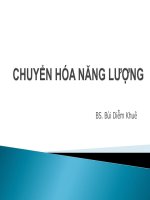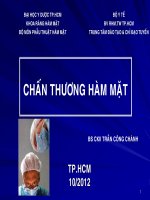CARDIOGENIC SHOCK , SỐC TIM, ĐH Y DƯỢC TP HCM
Bạn đang xem bản rút gọn của tài liệu. Xem và tải ngay bản đầy đủ của tài liệu tại đây (752.35 KB, 24 trang )
CARDIOGENIC
SHOCK
Vu Minh Phuc MD. PhD.
04-2012
CONTENTS
1.
2.
3.
4.
5.
6.
7.
04/14/20
Definition
Etiology
Pathophysiology
Clinical manifestation
Diagnosis
Management
Prevention
2
1. DEFINITION
Cardiogenic shock is a condition of
inadequate tissue perfusion resulting
from myocardial dysfunction.
The clinical definition of cardiogenic
shock is decreased cardiac output and
evidence of tissue hypoxia in the
presence of adequate intravascular.
04/14/20
3
2. ETIOLOGY
(1)
(2)
(3)
(4)
(5)
Congenital heart disease
Myocarditis (virus, bacteria, sepsis, noninfectious inflammation)
Poisoning or drug toxicity
Myocardial injury (trauma, cardiac surgery)
Cardiomyopathy
–
–
inherited abnormality: DCM, HCM, RCM, NCCM
acquired abnormality of pumping function
•
Myocardial ischemia or infarction
•
Secondary to valvular heart diseases
(6) Acute valvular heart diseases: AR, MR, AS, prosthetic valve thrombosis
(7) Arrhythmia
(8) Obstruction: tamponade, contrictive pericarditis, myxoma
(9) End stage of other kinds of shock
04/14/20
4
3. PATHOPHYSIOLOGY
Preload
variable
Circulation volume
CARDIOGENIC SHOCK
Contractility
decreased
Afterload
increased
Cardiac output (CO) = Stroke Volume (SV) × Heart Rate (HR)
cathecholamine
04/14/20
5
2. PATHOPHYSIOLOGY
COMPENSATORY AND PATHOLOGIC MECHANISMS
SVR (due to cathecholamine) → redirect blood flow from
peripheral and splanchnic to the heart and brain.
HR and SVR → LV work & myocardial oxygen consumption.
SVR → SV when pumping function of the heart is poor.
4 venous tone → CVP (right atrial) and pulmonary capillary pressure
(left atrial).
(5) Renal perfusion → activation of renin-angiotensin-aldosterol → renal
fluid retention
(4) + (5) Pulmonary edema
04/14/20
6
3. PATHOPHYSIOLOGY
COMPENSATORY AND PATHOLOGIC MECHANISMS
SV
A
B
normal ventricular contractility
A’
C
C’
poor ventricular function
SVR
The relationship between stroke volume (SV) and systemic
vascular resistance (RSV)
04/14/20
7
4. CLINICAL MANIFESTATIONS
Findings consistent with cardiogenic shock
Primary Assessment
Findings
A
B
C
Assessment of
Cardiovascular Function
Assessment of
End-Organ Funtion
D
04/14/20E
• Tachypnea
• Increased respiratory effort (retractions, nasal flaring) resulting from
pulmonary edema
Tachycardia
Normal or low BP with a narrow pulse pressure
Weak or absent peripheral pulses
Delayed capillary refill with cool extremities
Signs of congestive heart failure (eg, pulmonary edema, hepatomegaly,
jugular venous distention)
• Cyanosis, low SpO2 (caused by cyanotic CHD or pulmonary edema)
• Cold, pale, diaphoretic skin
• Changes in mental status
• Oliguria
•
•
•
•
•
• Changes in mental status
• Variable temperature
8
5. DIAGNOSIS
1.
2.
Positive Diagnosis : presence of signs & symptoms of
–
–
Shock and
Heart failure
Differential Diagnosis with other kinds of shock
–
Hypovolemic shock
• Clinical picture of dehydration, bleeding or
hemorrhage
• Quiet tachypnea
– Septic shock
• Focal infection, hyper or hypothermia
• Systemic Inflammation Reaction Syndrome (SIRS)
04/14/20
9
5. DIAGNOSIS
3.
Diagnosis of causes
History, examination suggest
Diagnostic tests
1. Congenital heart disease
ECG, CXR, Echocardiography
2. Myocarditis (virus, bacteria,
sepsis, noninfectious
inflammation)
Echocardigraphy, biopsy, Mac-Elisa, blood
culture, immunologic tests
3. Cardiomyopathy (DCM, HCM,
RCM, NCCM), valvular diseases
Echocardigraphy
4. Myocardial ischemia or
infarction
ECG, Echo, cardiac isoenzymes, cardiac
cath/angio,
5. Arrhythmia
ECG
7. Tamponade, contrictive
pericarditis, myxoma
Echocardigraphy
04/14/20
10
5. DIAGNOSIS
4.
Assessment of End-Organ Function and complications
–
Hypoxemia and acidosis : Ionogram, arterial blood gas
(ABG), central venous oxygen saturation, plasma
lactate, hemoglobinemia
–
Kidney : urinary analysis, renal function
–
Liver : liver function, coagulation test, blood glucose
–
Heart : cardiac isoenzymes, ECG, echocardiogram
04/14/20
11
6. MANAGEMENT
Main objectives
1. To improve the effectiveness of cardiac function
and overall cardiac output by increasing the
efficiency of ventricular emptying.
2. To minimize interventions or host responses that
increase metabolic demand.
Treatment
1.
2.
3.
4.
Airway support
To exclude the cause of cardiogenic shock
Treatment of shock
Treatment of complications
12
04/14/20
6. MANAGEMENT
AIRWAY SUPPORT
1. Monitoring of hypoxemia
–
–
Continuously follow up SpO2
Central lines: CVP, arterial line, PA line (± )
→ ABG, central venous oxygen saturation, PA pressure
2. Airway support
–
–
High flow oxygen is indicated.
NCPAP or BiPAP or ventilator : pulmonary edema.
04/14/20
13
6. MANAGEMENT
EXCLUDE THE CAUSES OF CARDIOGENIC SHOCK
1. At the same time of treatment of shock
–
–
–
–
–
–
CHD: specific procedures (BAS, balloon pulmonary valvar dilation,
PGE1, ..)
Viral myocarditis : gamma globulin
Bacterial myocarditis, sepsis : antibiotics
Myocarditis in rheumatic diseases: corticosteroids
Myocardial ischemia or infarction, poisoning or drug toxicity: specific
treatments
Treatment of other kinds of shocks
2. Before treatment of shock
Antiarrhythmia drugs (arrhythmia), pericardiocentesis (tamponade)
3. After treatment of shock
Cardiac surgery (CHD, valvular heart disease)
04/14/20
14
04/14/20
15
04/14/20
16
6. MANAGEMENT
Preload
variable
TREATMENT OF SHOCK
1. Fluid administration?
Contractility
decreased
2. Inotropic agents?
Afterload
increased
3. Reduce afterload?
04/14/20
17
6. MANAGEMENT
TREATMENT OF SHOCK
1.
Fluid administration
∗ WHEN?
•
•
•
Presence of dehydration.
Presence of risk factors of inadequate preload: poor intake,
fever, vomitting, diarrhea.
Low CVP, ventricle’s volume on echocardiogram.
∗ HOW? and WHAT?
•
•
•
Cautiously and slowly give 5-10 mL/kg isotonic crystalloid
infusion over 10-20 minutes
Frequently assess respiratory function during fluid therapy
→ respiratory distress, pulmonary edema?
NCPAP, BiPAP, ventilator are ready.
18
04/14/20
6. MANAGEMENT
TREATMENT OF SHOCK
2. Inotropic agents
DRUGS
CLASS
INOTROPE
CHRONOTROPE
LISITROPE
SVR
1. Dopamine
Inotrope
Vasoconstrictor
++
+ (high dose)
−
(high dose)
2. Dobutamine
β1 > β2 > α
Inotrope
++
+ (high dose)
−
(high dose)
3. Epinephrine
β1 = β2 > α
Inotrope
Vasoconstrictor
++
+
−
(high dose)
4. Norepinephrine
β1 > α > β2
Vasoconstrictor
+
+
−
5. Milrinone
(PD3 inhibitor)
Inodilators
+
−
+
6. Nitroglycerin
7. Nitroprusside
Vasodilators
−
−
−
8. Vasopressin
Vasoconstrictor
−
−
−
04/14/20
venous tone
19
6. MANAGEMENT
TREATMENT OF SHOCK
2. Inotropic agents
* WHAT KINDS?
- Normal systolic BP = 90 + 2n (n = age) mmHg
- Hypotension
systolic BP < 70 + 2n ( < 90) mmHg
- Fatal hypotension
systoilc BP < 60 + 2n (< 70) mmHg
Fatal hypotension → MOD → irreversible shock → die
Inotrope agents has strong vasoconstriction
(High dose Dopamine or Epinephrine or Norepinephrine)
Hypotension
Inotrope agents can SVR
(Dobutamine or Milrinone + Dopamine –renal dose)
Normal BP : Vasodilators (Nitroglycerin or Nitroprusside)
20
04/14/20
6. MANAGEMENT
TREATMENT OF SHOCK
2. Inotropic agents
* WHAT KINDS?
RV failure
- preload is very important for RV’s compliance and
contractility
- volume infusion until systolic BP > 70 + 2n (>90) mmHg,
CVP > 10 cm H20.
- afterload # pulmonary arterial resistance
- Milrinone, Dobutamine are preferred
21
04/14/20
6. MANAGEMENT
TREATMENT OF SHOCK
2. Inotropic agents
* HOW TO USE?
Fatal hypotension
Inotrope agent has strong vasoconstriction
- Epinephrine or
- Norepinephrine
Hypotension
Inotrope agents can SVR
- gradually then off Epi or Norepi
- and Dobutamine or Milrinone
- High dose Dopamine or
(gradually the dose if no response)
- and Dopamine-renal dose
(gradually to renal dose)
Stable hemodynamics
Don’t change the drugs’ dose for ≥ 24 hours
Stable hemodynamics
Gradually drugs’ dose then off
22
6. MANAGEMENT
TREATMENT OF COMPLICATIONS
1. Adjust electrolyte and acid-base balance
2. Acute renal failure
3. Digestive hemorrhagia due to stress
4. DIC
5. Acute pulmonary edema associated with cardiogenic
shock
• Give diuresis even patient in shock
• Morphine and Nitroglycerin are contraindicated
23
04/14/20
Thanks for your attention
04/14/20
24









